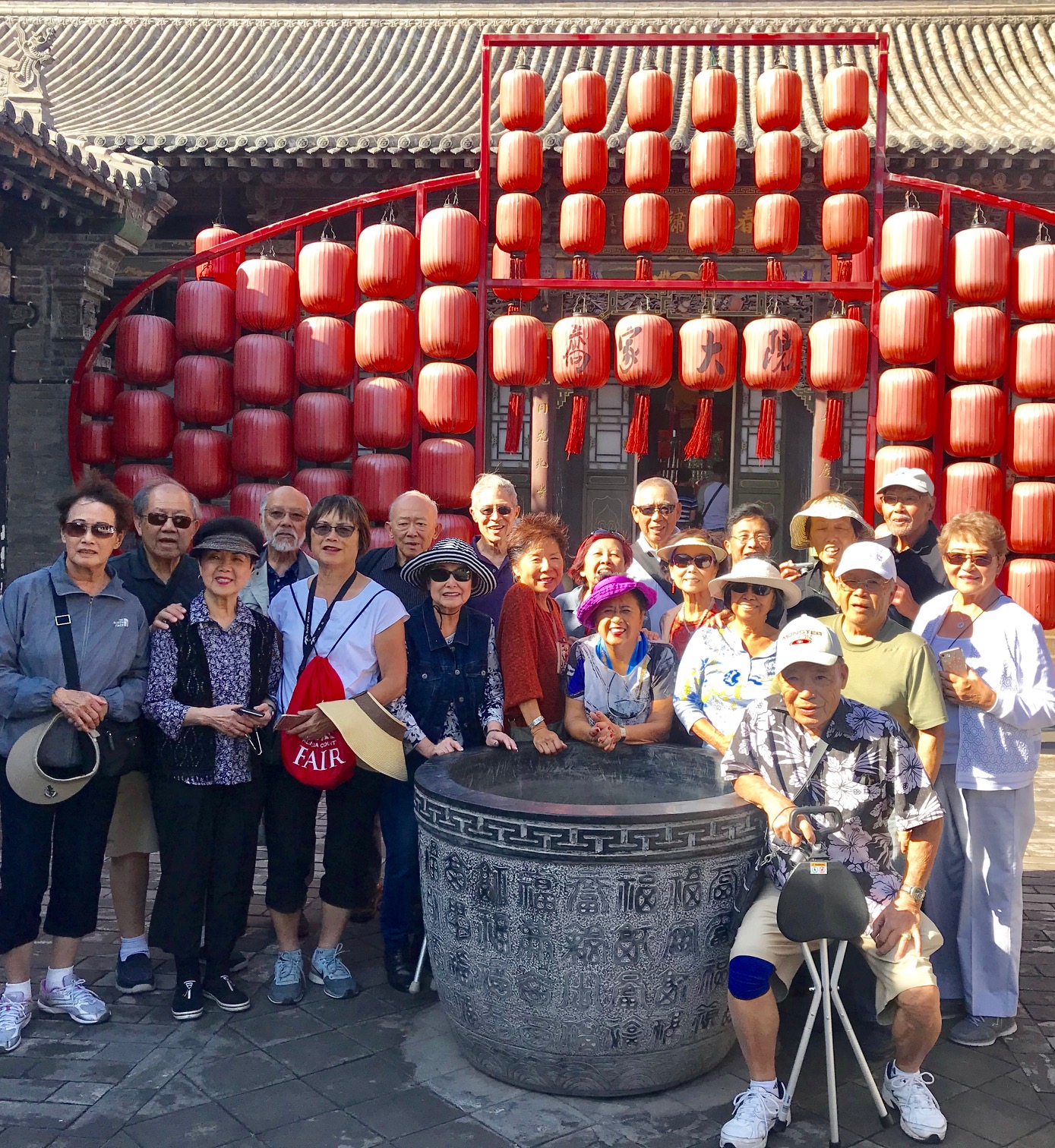
FABULOUS FOODS AND FANCIFUL PLACES IN CHINA
FABULOUS FOODS AND FANCIFUL PLACES IN CHINA
By Gerrye Wong October 8, 2018
As most of you readers have no doubt figured out by now, this writer is a true China lover who has visited this land of my roots since 1976 to now, some 42 years span, of over 30 times….and always yearning for the next time. Remember, China is a big country, and there are always new sites to visit and explore. Those places we re-visit change unbelievably every few years so they are almost non-recognizable and always have newer different places within to view. So, here dear reader, is the story of another wonderful adventure to China, seeing places heretofore unknown to most foreign tourists, and with my special China Chums group who have China roots and embrace each new site with enthusiasm and curiosity. All have visited China many times, but remain eager in mind and active senior bodies to see more. Here is our 2018 tale…..
Our trip began on September 12, and yes, it is a long plane ride over, but alas, seat-back movie screens help capture those 15 hours with 4 movies which I find are made more comfortable with a soft material neck cushion and inflatable seat cushion, tiny in-ear noise-cancelling earphones, warm socks, tennis ball to place on various aching back spots, and a soft sided tote bag chock-filled with food snacks, magazines, and knitting supplies for my short legs to prop feet on to prevent seat-slouching. China here I come….
My annual tour is arranged through expert travel guide, Frank Chang, chef owner of Santa Clara’s popular China Stix Restaurant, who sees to it our special troupe of China adventurers visit new undiscovered tourist sites and are introduced to new gastronomic pleasures through his culinary connections. He and I search for new UNESCO World Heritage Destinations, places of historical relevance, and exciting destinations showcasing China’s natural scenic wonders.
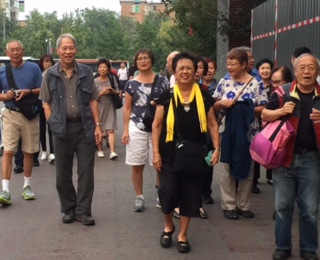
This year our two week trip took us from Shangdong to Shanxi Provinces, visiting a Ten Thousands Year Old Ice Cave, the Tianjin Binhai library designed spectacularly by Dutch architect with no books in sight, a beach marshland that shines bright red in the fall, Simatai, a lesser known part of the Great Wall, the Taihangshan National Park with spectacular scenery and glass walkway, two once luxurious Ching Dynasty residences circa 1600s, the Yin Dynasty Ruins museum exhibiting an Empress’ tomb, Xiangyu old Imperial City and Gubei Old Water Town. Throw in three daily over-the-top meals of Chinese regional cuisines, and yes, it was a feast time for both eyes, taste buds and curious minds of my group of mostly non-Mandarin- speaking Chinese American seniors! All agreed, it was an action-packed unforgettable time learning about the land of their forefathers….
First day’s welcome in Beijing: Beijing International Airport is a huge modern edifice for tired legs to trudge on through security and to the baggage area which seems miles long, but wheel chair assistance and efficient Assistant Guide Alesha gets us to our hotel efficiently. Next day taxis whisk us to Silk Market for shopping excursion for China-made souvenirs, purses, silk goods and you name it, China makes it. Soon after we gather our 21 member group members and our large bus takes us to our first dining adventure.

As we walk up the street, a bright sign at the ZHI LI HOUSE restaurant welcomes the Frank Chang Group and we are greeted by owner Mr. Liang Lian Qi , who is proclaimed the master chef of Hebei cuisine.
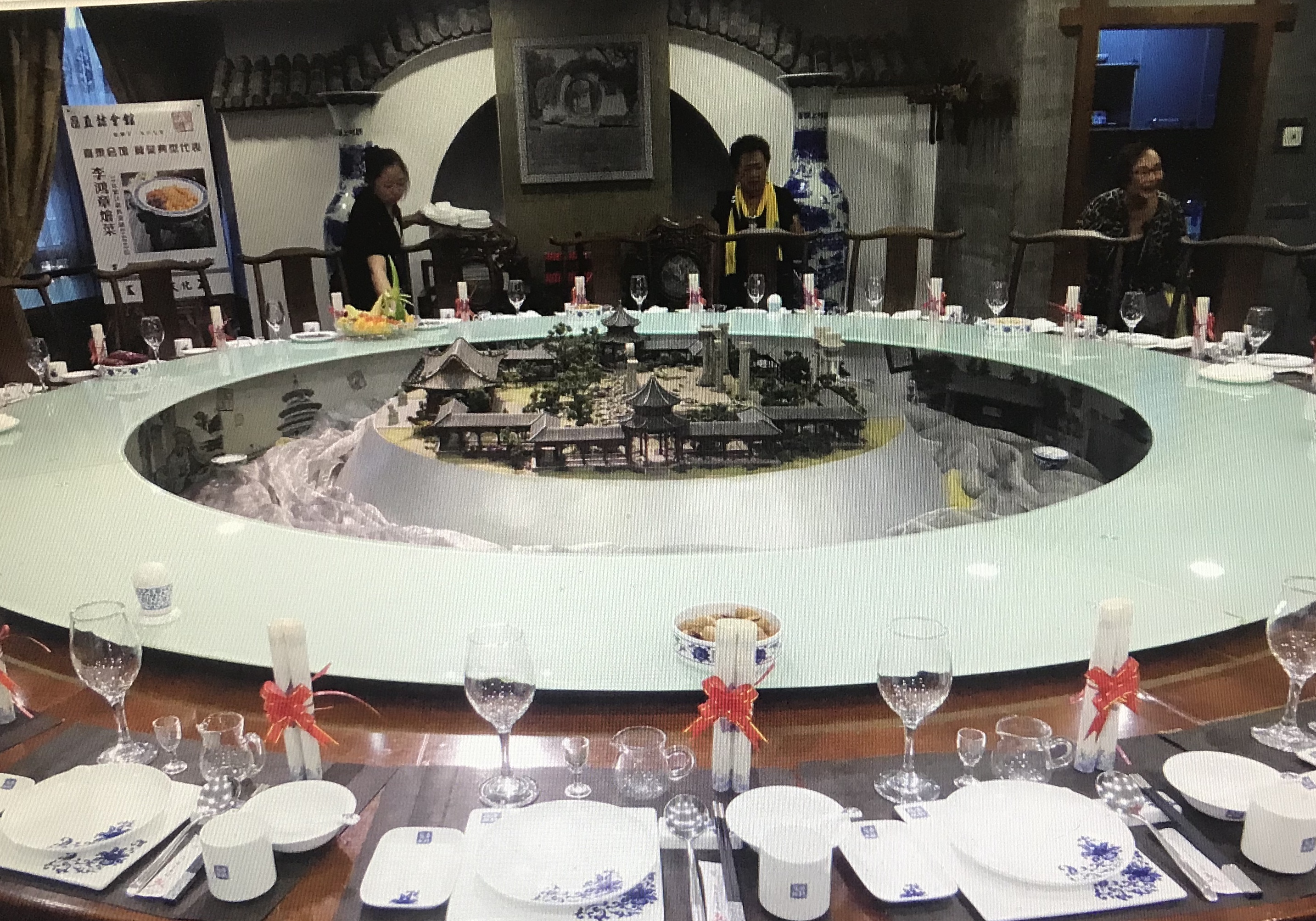
We are pleasantly surprised being led to a private room showcasing a large decorated dining table set for 22 guests. Each place setting had a rolled up be-ribboned parchment paper menu informing us we would be enjoying 8 cold snack dishes, 8 cold and 16 hot entrees for our Imperial Dinner.
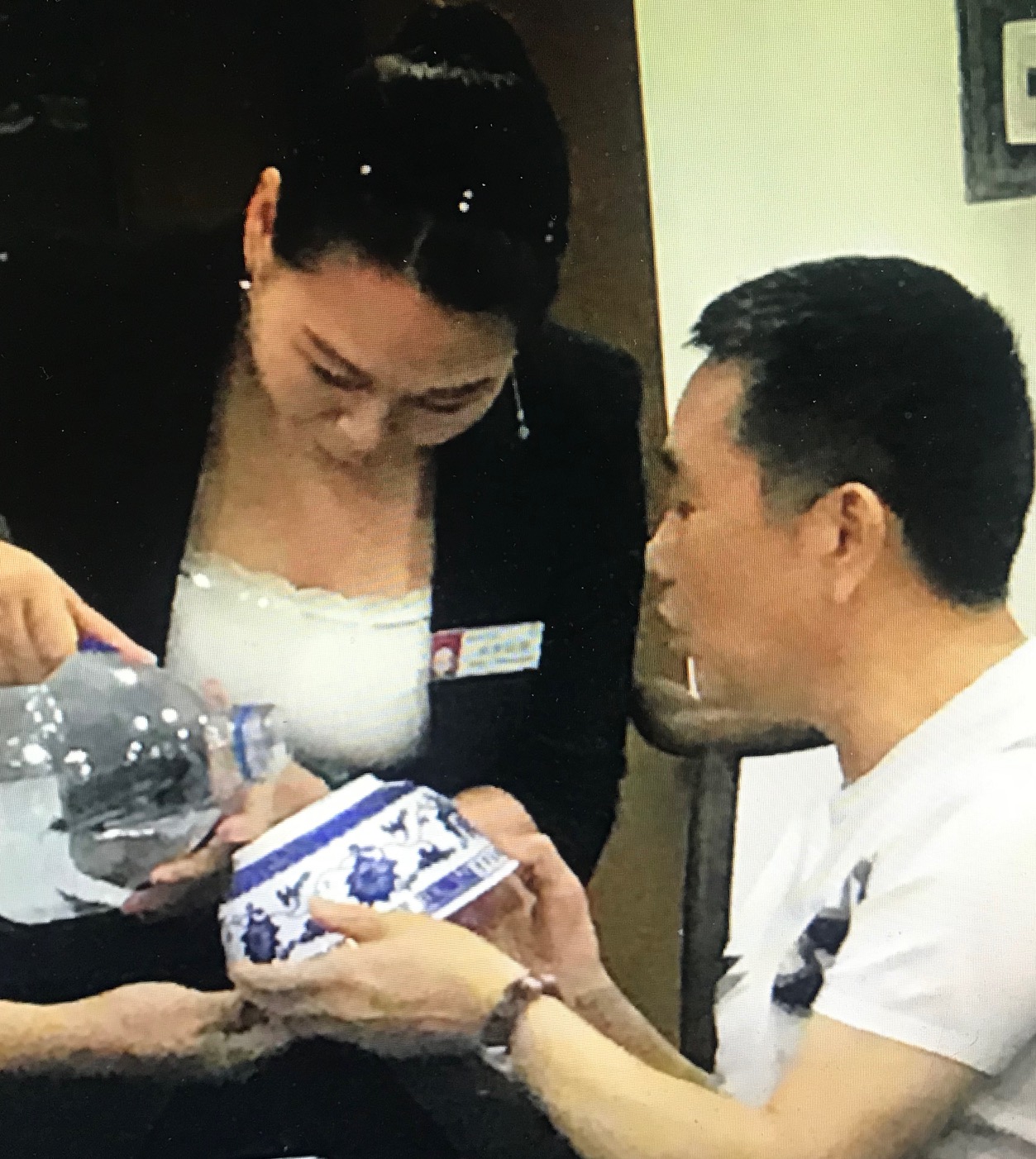
Special porcelain serving dishes were shown which have inner linings in which hot water can be inserted to ensure the food will be kept warm, as demonstrated by the wait staff. These are specially designed dishes by Mr. Liang and only available for purchase through the restaurant.
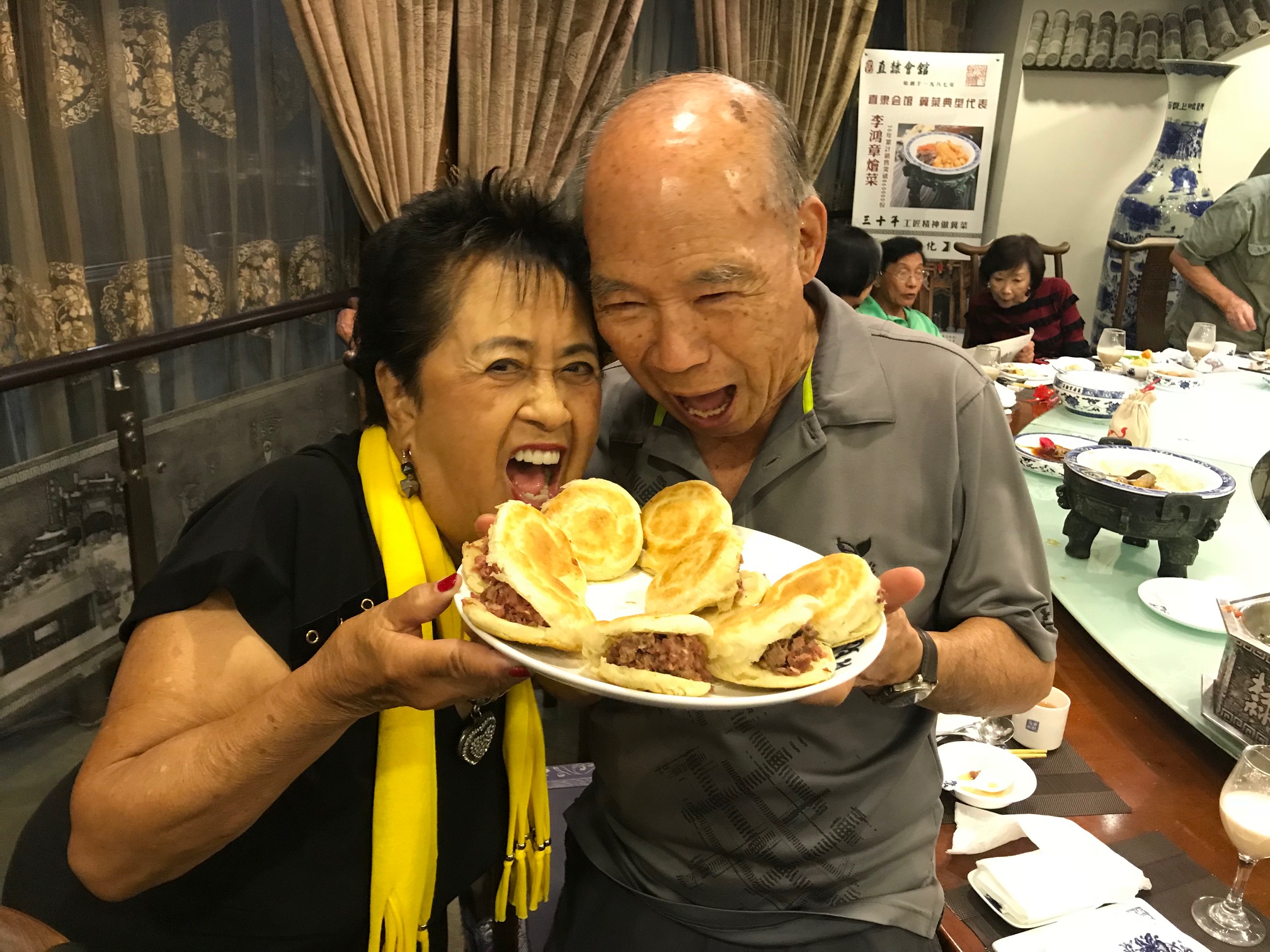
As per custom, a cold noodle dish concludes the meal in addition to Chinese donkey meat hamburgers. Albeit a bit strange to our western minds, nevertheless many of our group, including the Howard Setos, Howard Lums, Andrew Zees and we Wongs were good sports to try this new hamburger variety.
Day Two of our tour was enjoying not only the hotels buffet of every variety of breakfast you could dream for, but we enjoyed two specialty meals after. Lunch was at the famous Da Dong Restaurant, which has grown to many branches throughout Beijing and China. Its signature offering is Peking Duck, shown on display being cooked in this modern design restaurant, as well as shown being individually sliced into over 70 small slices by chefs at each table. Another dish the restaurant is noted for is its goose liver foi gras, something not usually expected in a Chinese restaurant.
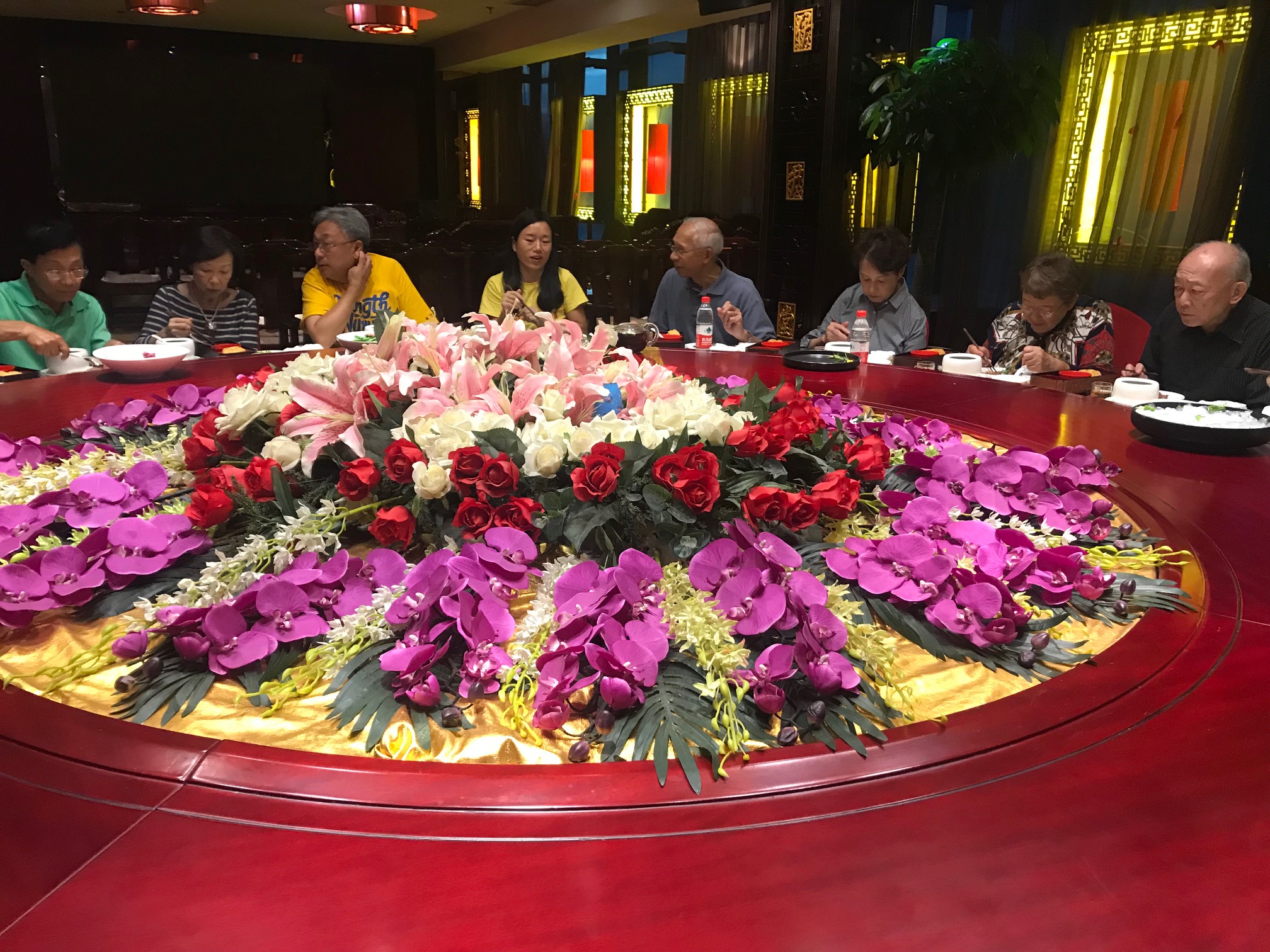
Still reeling from this gourmet lunch, we are treated to another well known restaurant, the Yi Yin Sea Cucumber Restaurant that welcomes us to a large 22 person round table with its lazy susan grandly decorated with colorful flowers in the center. The dinner feast prevailed upon us with different dishes made of sea cucumber. Most memorable was its fresh sea cucumber soup with seaweed, agreed diners the Tom Tanabes, Ralph Gins, Ginger Lai and Al Low.
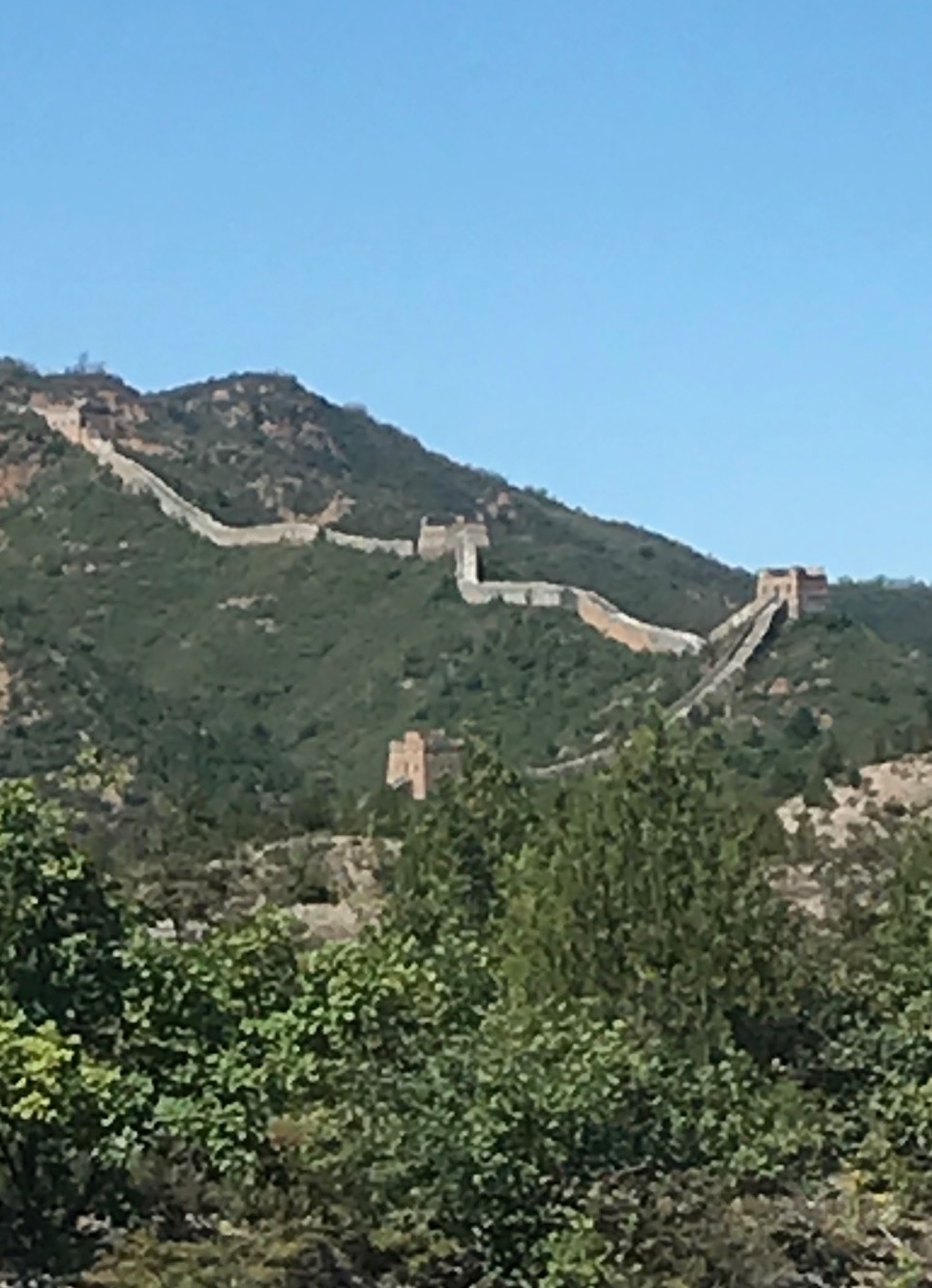
Day Four was a strenuous walking day, but everyone agreed was much needed to hike off the calories and pounds gained the day before. A visit to the Simitai Great Wall section entailed a 2 hour ride in our large comfortable 50 passenger bus, then a ride in a 10 passenger bus followed by floating in the air in an 8 passenger gondola ride up the mountain. Hardy souls then hiked up to the Great Wall for great photo ops and memory of being on this great China masterpiece of construction.
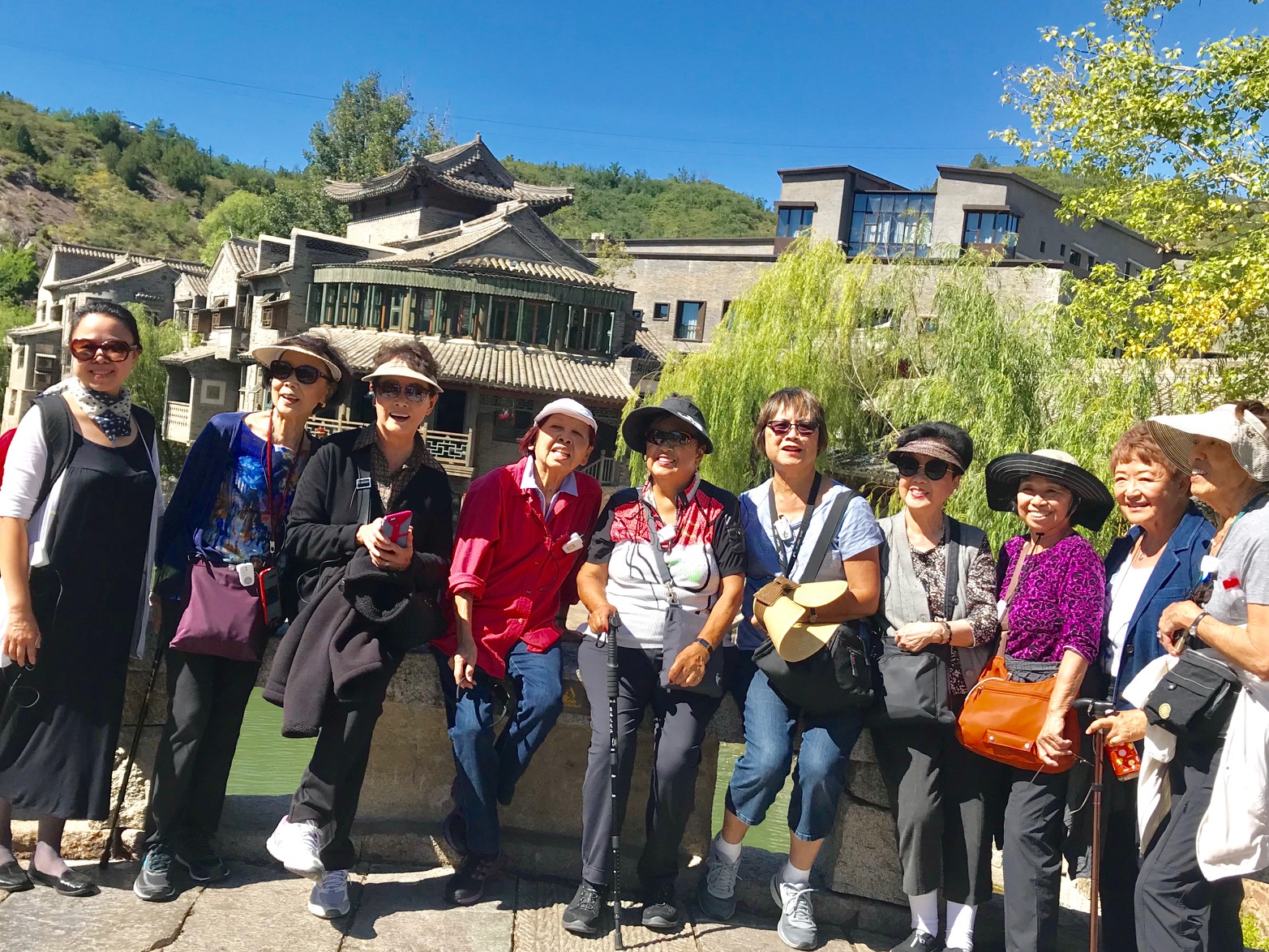
Next was a walk through a newly recreation of the Gubei Old Water Town showing how the town once looked centuries ago. A very tired group welcomed the long ride back to Beijing, made 2 hours longer fighting late day traffic through Beijing, which we were told is often a common occurrence nowadays with the outgrowth of too many cars in an overcrowded area. Alas, we arrived in the evening to the height of luxury surroundings of the Hotel Tianjin St Regis, a relief after a tiring travel day.
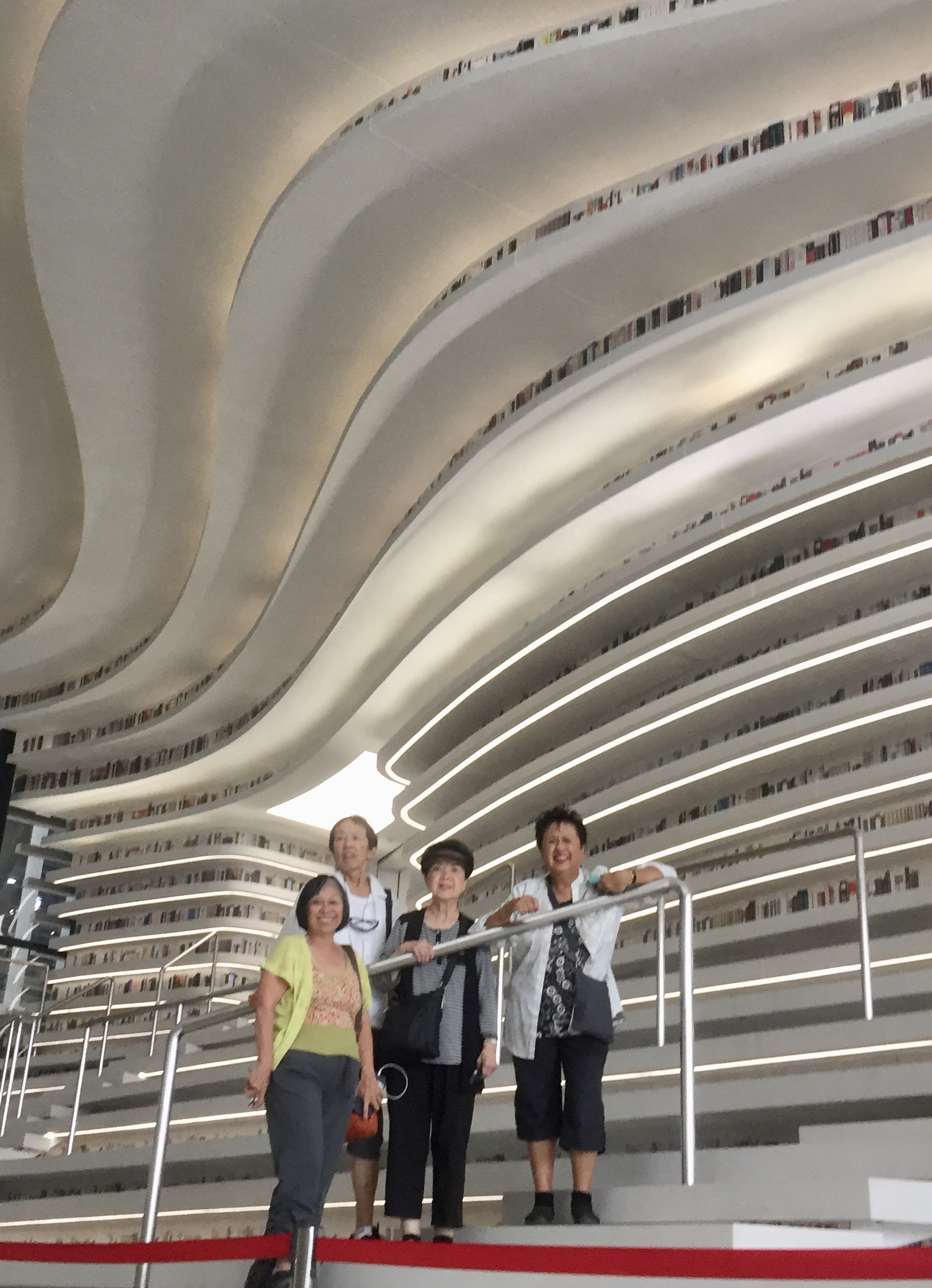
Undaunted and ready for more adventure the next day, our group views the city of Tianjin with its noted architecture as we ride to a suburb of Tianjin to visit the noted Binhai Library which opened last year as designed by famed Dutch Architect. Its curved two-story walls has built in areas to sit, but most unbelievable is the fact that no books are displayed in its many shelves, only painted book covers. A large round ball in the center has announcements and art work flashing on its circumference to make this area even more unique. When one wants to take out a book, he has to go behind the walls to separate areas not seen in its modern design.
Back in Tianjin city, we take a boat ride down the river which cuts through the center of the city, 73 meters long. Our voyage showed us the nine interesting bridges, and the different architecture that the city is known for in its buildings. Memorable of this city is that it housed the first women’s college in China, has 16 million population now, and showcases a Japanese inspired Ferris Wheel giving a 30 minute ride to 140 people at a time. Looking at all the modern buildings and the beautifully lit buildings at night, we all had to agree, yes, China doesn’t look like it did a mere 60 years ago under a closed-to-the-world Communist domination.
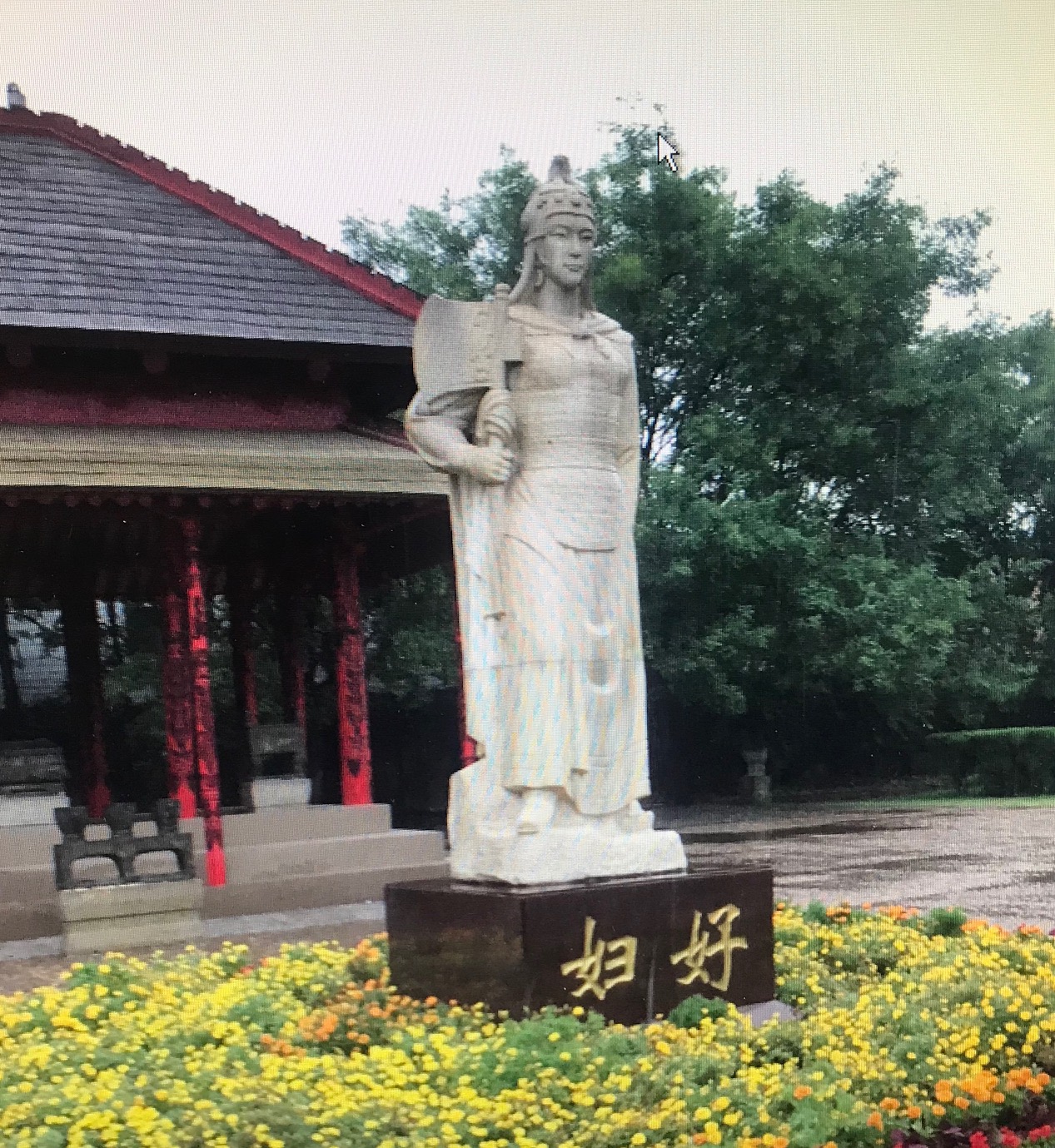
Day 6 takes us on to a three-hour Bullet Train ride to Anyang in Henan Province to visit Yin Dynasty Ruins in an indoor/outdoor museum. A truck took our luggage, thankfully, so we could get on and off the train easily, which is said to only give one 45 seconds for stops.
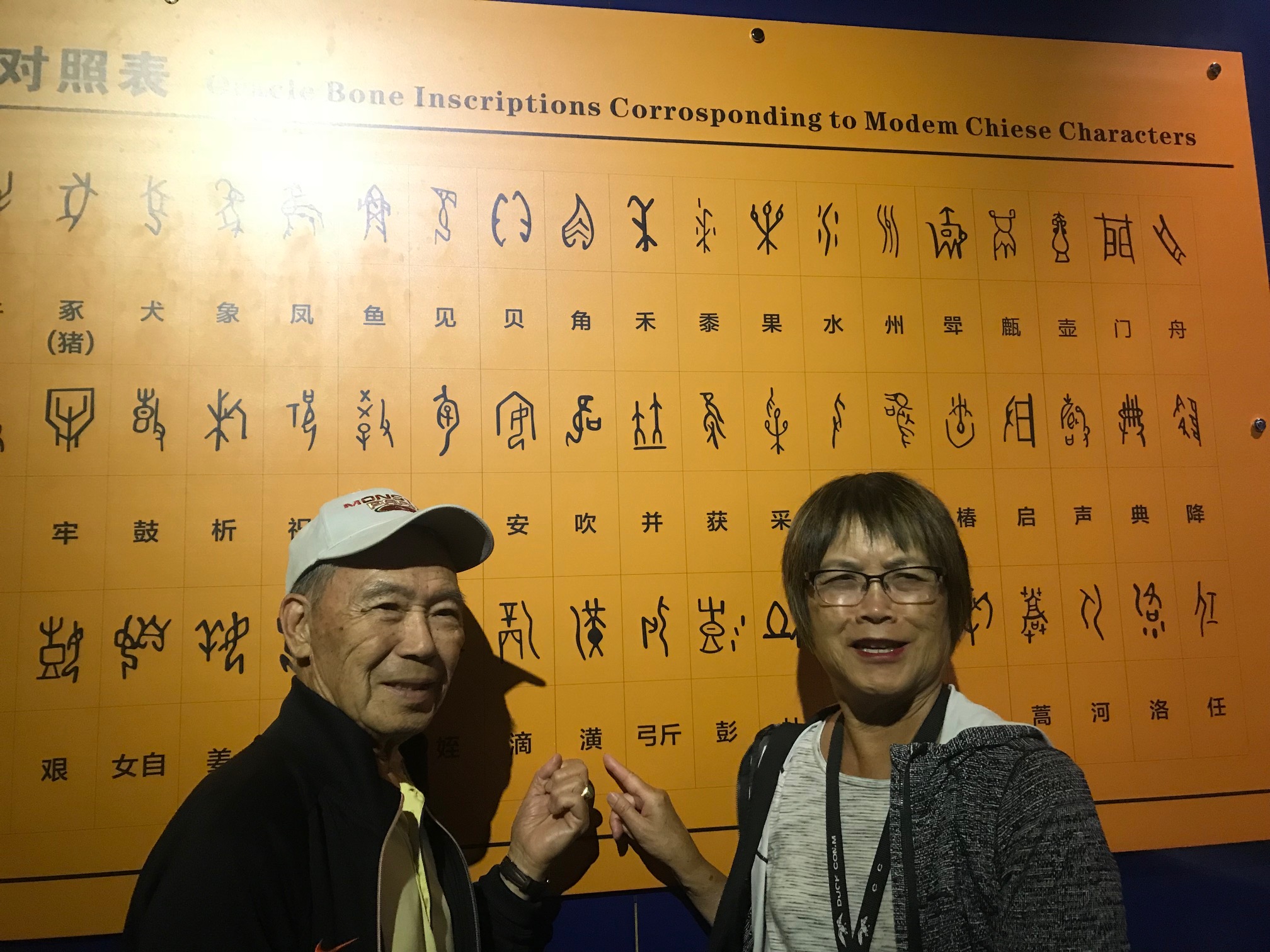
We pass farmland of corn, bean and peanuts where the land is also rich in production of coal and aluminum. At the museum we are shown tombs and artifacts dating back to 1409 BC for an informative history lesson, but a rainy day dampened our outdoor investigative spirits, unfortunately.
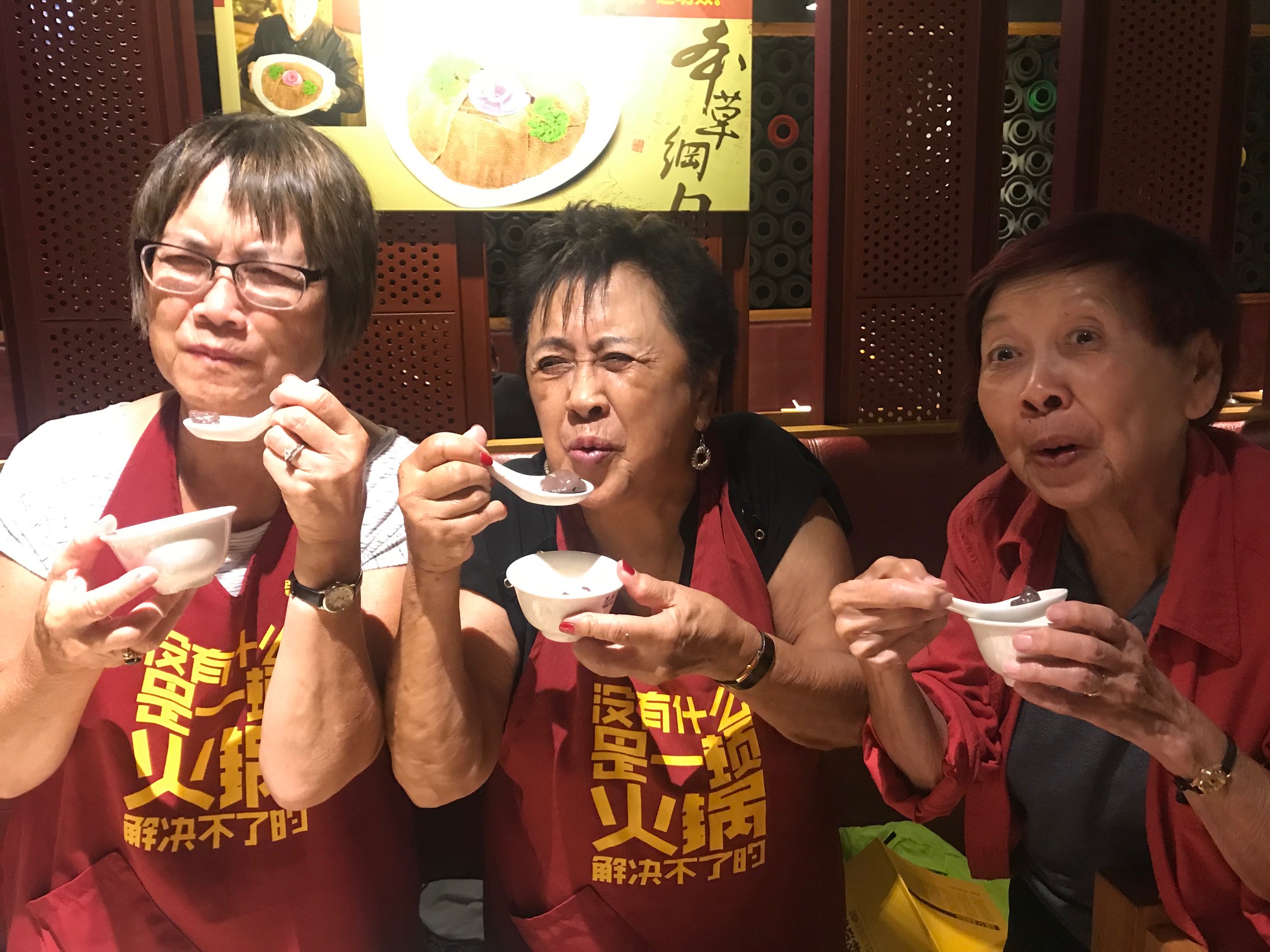
Later we are buoyed by the BaNu Hot Pot Dinner Restaurant which has 42 locations throughout China. In the center of the hot pot, which is divided into two sections, is a milky bone/mushroom broth base, into which we diners threw in a great selection of honey comb stomach tripe, shrimp, cuttlefish, crab roe cut into balls, chrysanthemum leaves, lotus root, calf esophagus, dried tofu sheets besides the usual meats and vegetables. Some of us “jook sings” were aghast at seeing goose blood being served, but Mary K Lim, Julie Gin and I found out it wasn’t so bad tasting after all.
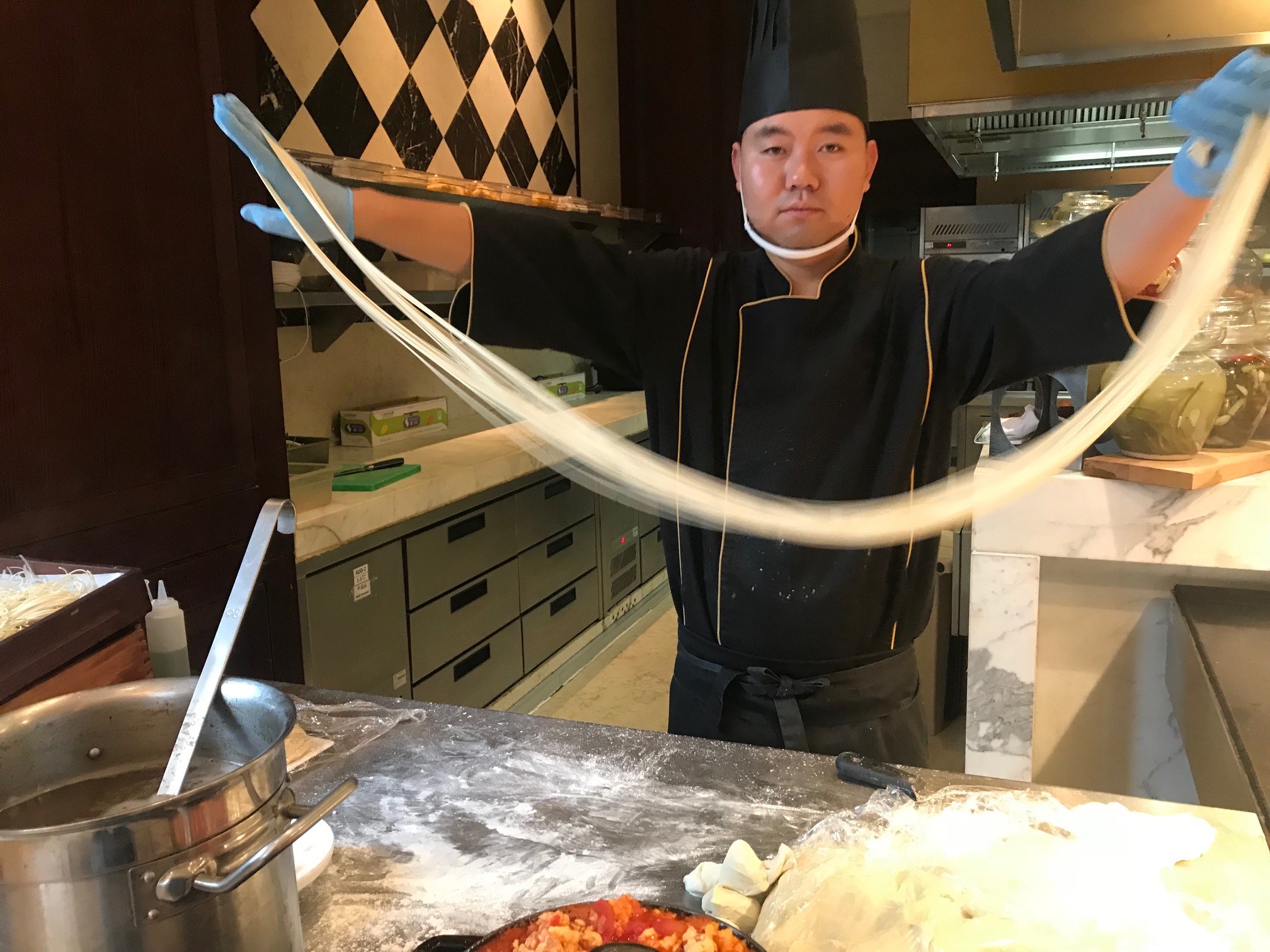
A fun time was seeing a master chef display noodle pulling, and then watching brave Ginger Lai and Andrew Zee try their own hands at stretching and flinging the string of dough around like a miniature jump rope to make their own pulled noodles. Luckily the long train ride, museum visit and heavy meal lulled us all to restful sleep as our poor driver suffered driving us through two hours of curving roads in horrid traffic to get us up to our mountainside Linzhou Hongqiqu Resort.
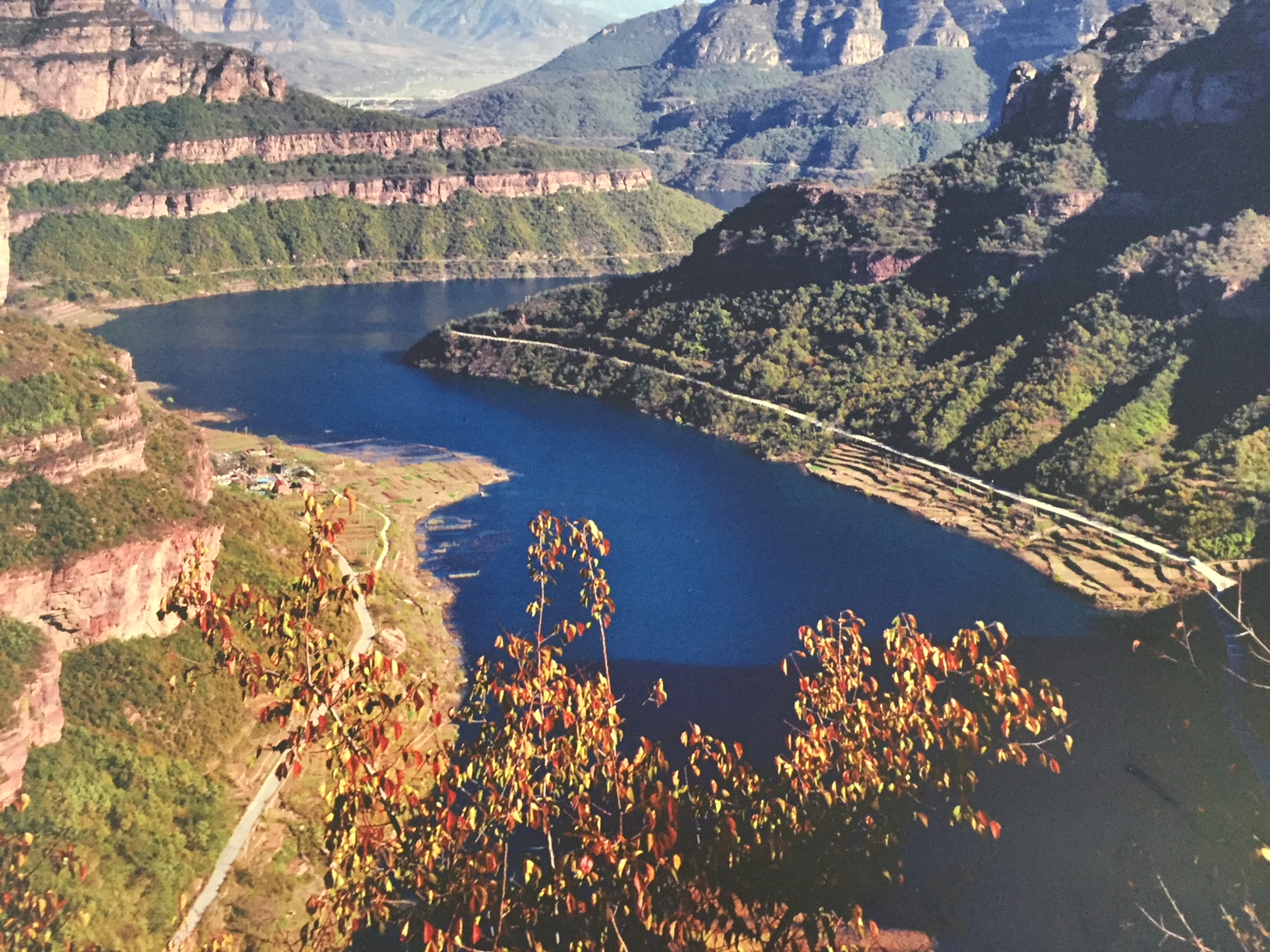
At our new Forest City location, our large resort hotel of 6 individual buildings, it is located conveniently near the Taihangshan mountains for summer and winter residents. This area is famous for a man-made canal which has been named the eighth man-made wonder of the world. Back in the 1960s, two million of the villagers were suffering with lack of water so independently they decided to build an aqueduct to divert water to needy villages. It took 10 years of hard labor to build the 900 mile canal, a fete done with primitive tools and much hardships. We saw glimpses of it as we drove to the Red Flag Grand Canyon.
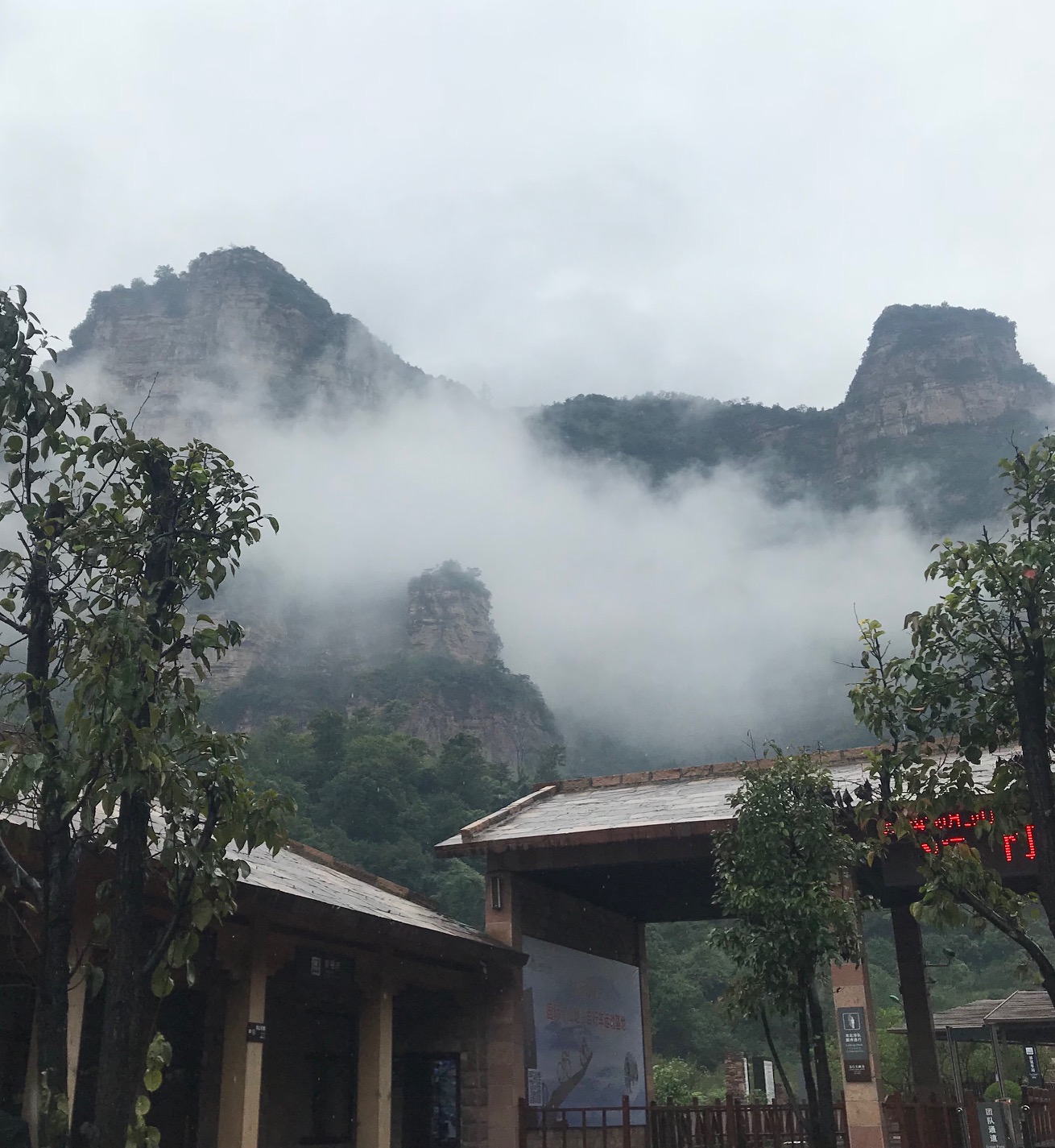
Today was our long awaited visit to Taihangshan National Park, its mountains said to have 7658 peaks and same amount of valleys inbetween. It is a gloomy rainy day with clouds drifting in and out making the view rather foggy and mystical. We did gather courage to step out and explore a small glass walkway over a steep canyon but missed the hiking adventure on walkways between three mountains most tourists venture on.
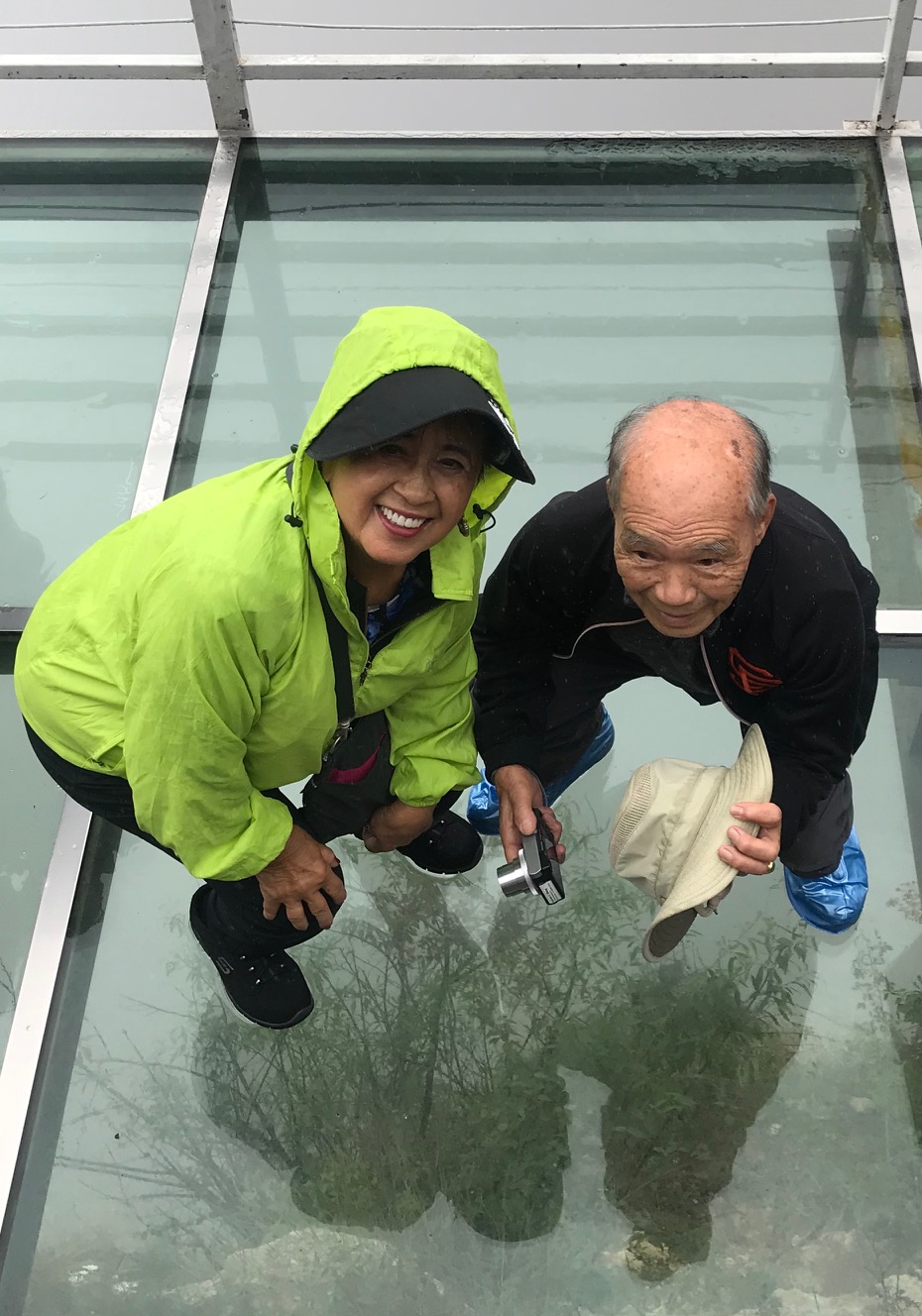
Day 7 brings us into the Shanxi Province which is a long narrow area and the oldest province in China. On the bus ride today we go through the Taihang mountains, a long string of mountains in this central part of China where wheat and coal mines are famous for. It was interesting to note that we passed many coal-carrying trucks which it selves run on gas and actually have their own gas tanks attached to use. We find out from our local guide, Johnny, who speaks excellent English, that most tourists who come to this area are interested in learning about China’s five thousand year old history of this region bordered by the great Wall on the north and Yellow River on the south. On our 60 mile stretch ride from east to west side of Taihang mountains we pass 13 tunnels and 91 bridges, no less so it was an interesting ride through the Henan Province farmland.
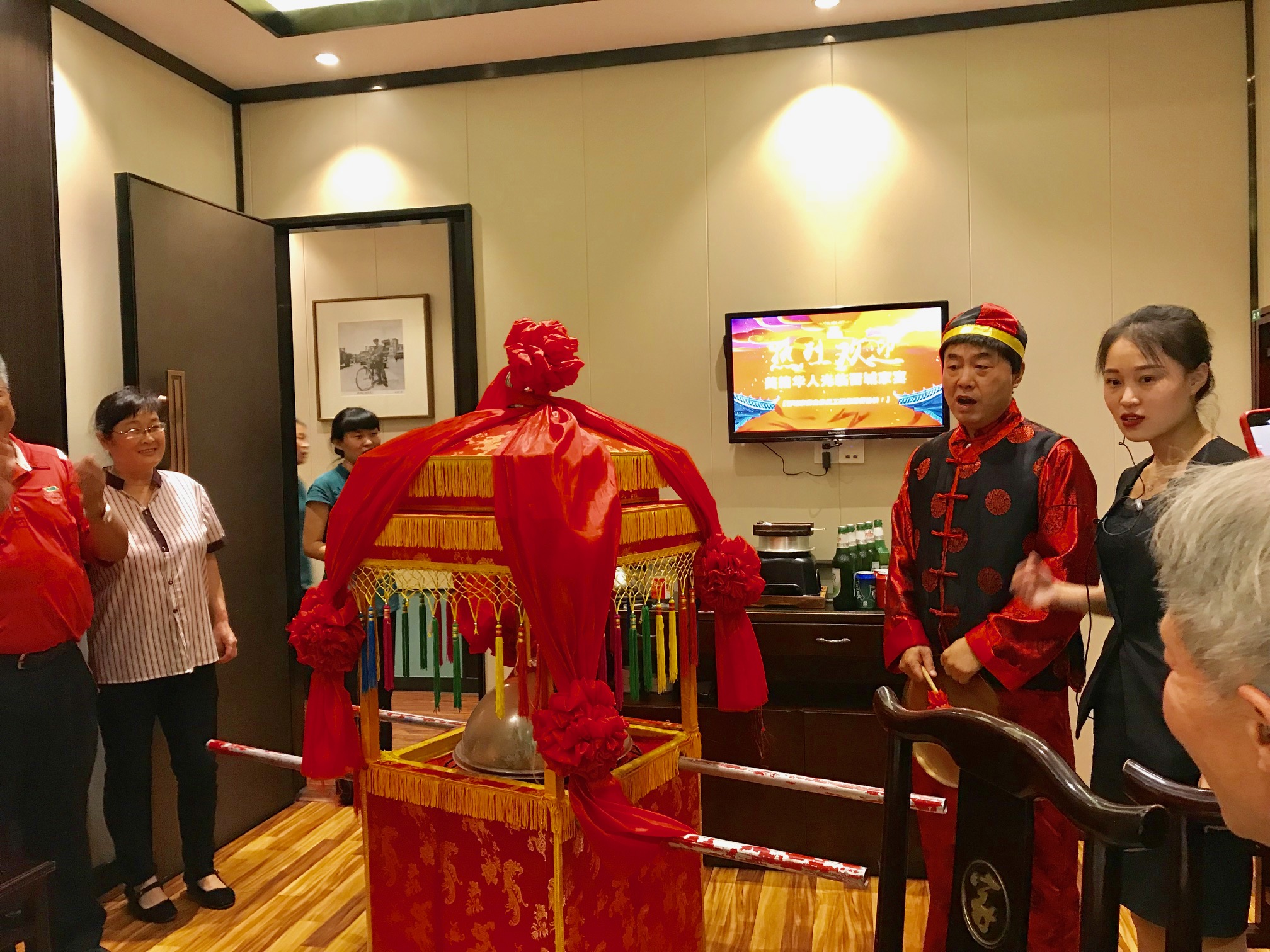
Highlight of the day, after visiting a Ching Dynasty residence of a government official who was once tutor of the emperor in the 1600s, was the Ten Bowls Feast Dinner of Gincheng Cuisine that evening.
Restauranteur owner Mr. Zheng, president of the Culinary Association, presented a dinner of authentic Shanxi cuisine which included many dishes made of pork. His signature dish was brought in ceremonial manner, following the sound of a gong, in a red sedan chair, which was opened to show a large bowl of Braised Big Head Carp, served to be eaten with fresh cooked Northeast China rice, according to our leader Culinary Expert Frank Chang. Another traditional dish would be served in a wooden container tied with a red ribbon. Once opened, it brings good luck to the diner when rice, olive oil and water is added to be cooked within. Other interesting dishes included a deep fried crispy noodle wrapped in tortilla-like skin to be filled like in Peking duck style, sticky rice with dates, and soup with gelatin like squares and seaweed. Another feast to behold.
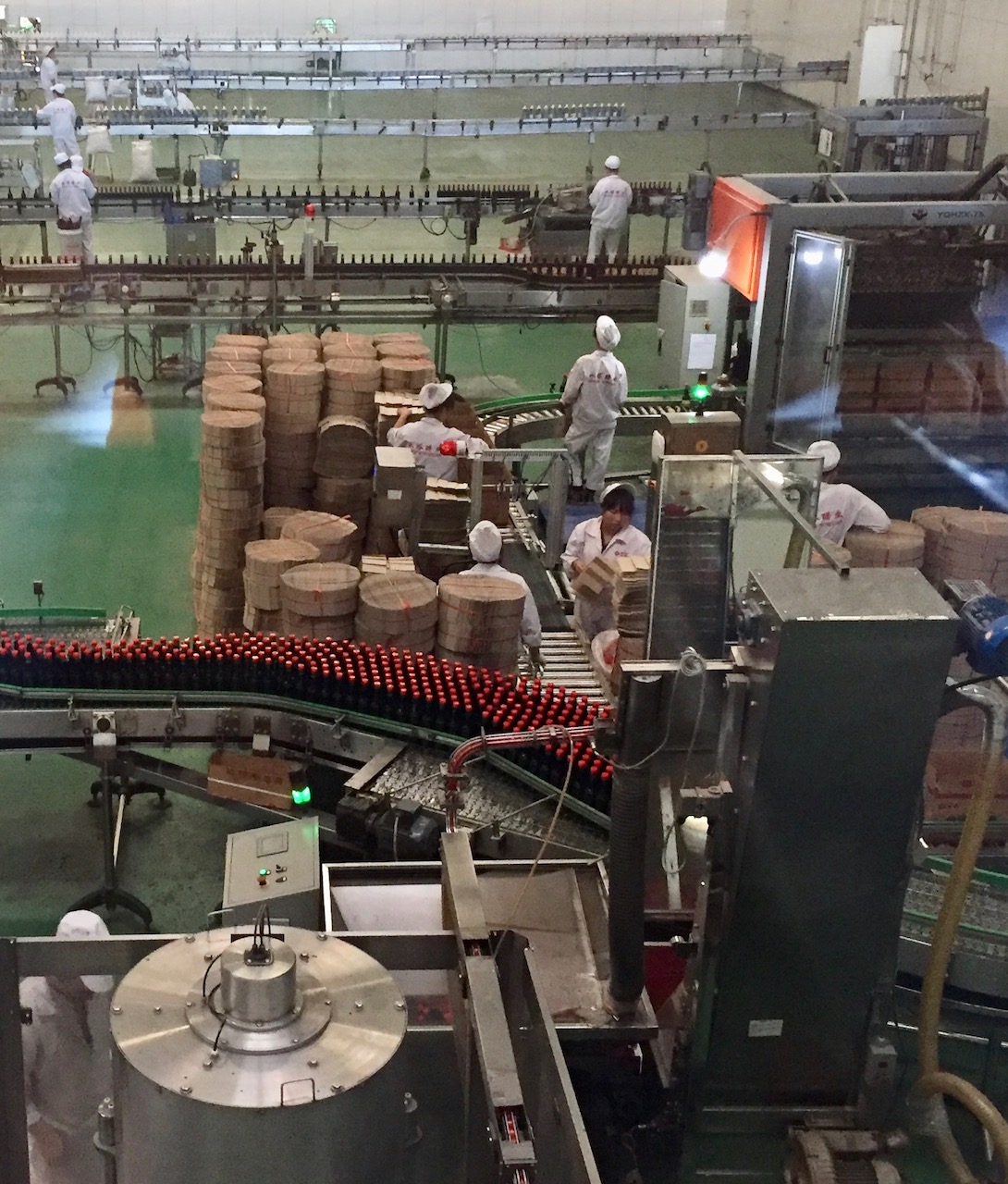
Day 9 has us bussing to the Capital of Shanxi Province, Taiyuan, known for its vinegar production. We visit the residence of the Chou Family, six generations of which have occupied it for 400 years. First generation member, an orphan began a dow foo business, and his subsequent generations that followed became successful businessmen trading with Russia.
Another feast highlight was meeting the Vice Chair of the Dim Sum Association, Mr. Gao Shao Jun who is well known throughout the world through his involvement in showing skills using wheat in different types of foods. At his restaurant, we are not only shown demonstrations of noodle blowing, noodle shaving, noodle throwing and noodle pulling, we are entertained on stage with music and dance performances by the restaurant staff members themselves..
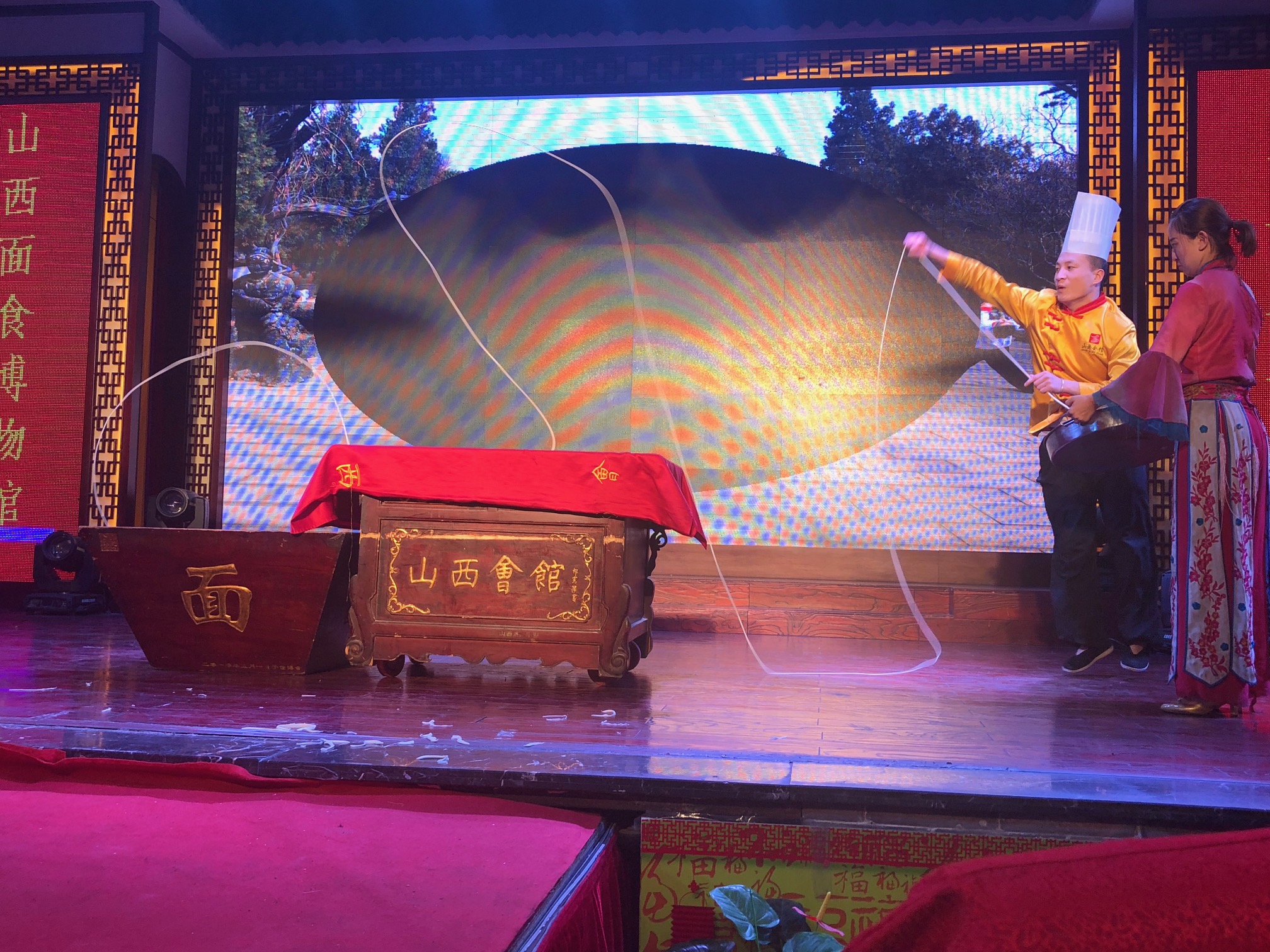
One act had the chef stretching and pulling the dough to expanse of 6 feet, winding it miraculously over and over to make over 16,000 thin strands looking as thin as silk threads.
With areas for demonstrations at the restaurant, which can accommodate over 1000 diners, it has become known as a museum of wheat based foods. Calvin Wong and Andrew Zee make valiant attempts at the art of noodle slicing and throwing before amused fellow travelers the Ken Lais, Sue Leong, and Sherwin Louies.

Day 10 is the long awaited day to visit the Ten Thousands Year Old Ice Cave in Xinzhou, Shanxi. When we arrive, a local farmers’ protest is blocking the government-managed cave, but luckily for us, the police settle the dispute when we return a few hours later. A walk through the cave is treacherous with slippery wooden steps and iced handrails as one maneuvers the narrow pathway surrounded by iced walls colorfully lit.
It was a long ride through the mountains to get here, but walking through this spectacle was well worth the travel time, everyone agreed. Each segment is colorfully lit to enhance the cave walled sculptures, and although it was easily in the 5F degree temperature zone, one was so fascinated by the sights, the cold was easily endured by us all and never disturbed our enjoyment of this wonderful sightseeing adventure.
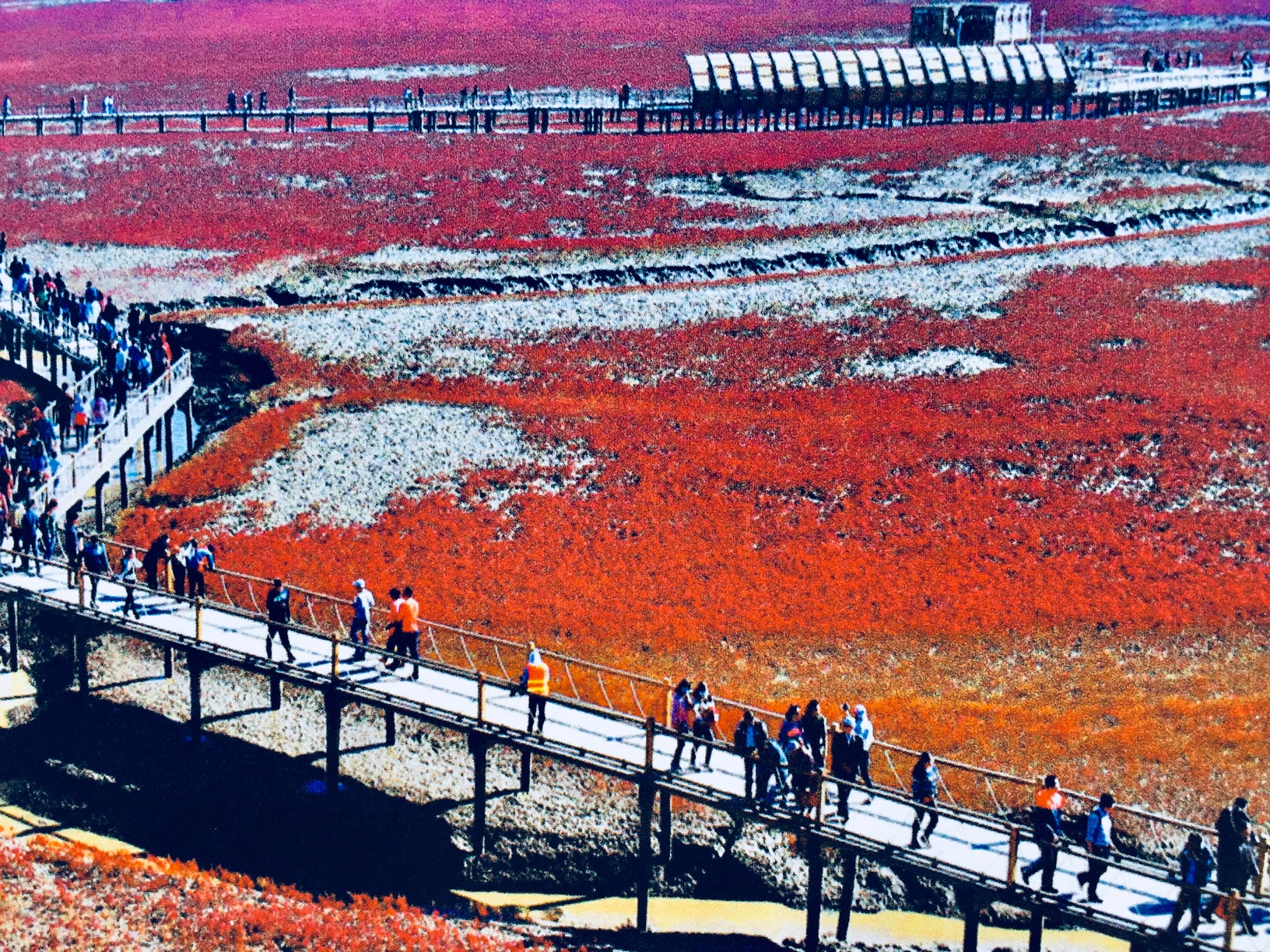
Day 11 flies us in one hour to Dalian, and followed by a train ride to Panjing where we visit the Jinghu Red Sea Marshland. This Red Beach area covers 50 miles and in fall, tiny Seepweed plants turn red making the area quite beautiful to the 15 million visitors who came last year, according to the guide.
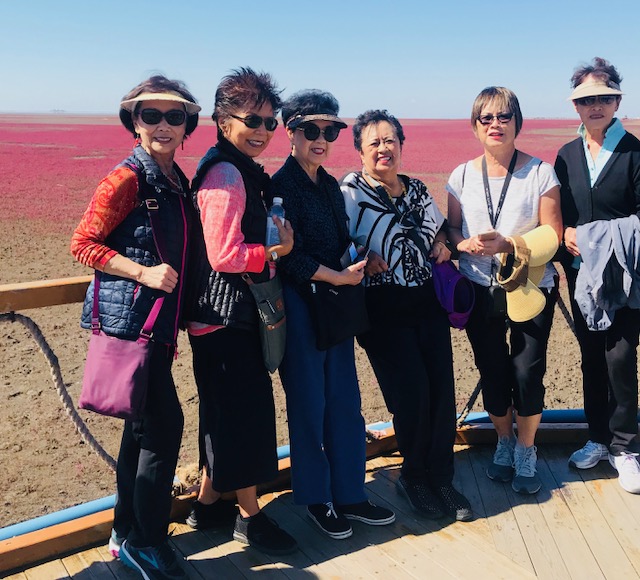
Stilted Walkways are built in various sections for tourists to walk out to see the marshland below as well as the tiny Cyan yellow river crabs which live in the muddy area. Panjin is a new city known for its hairy crab and jumbo shrimp, and the Red Sea Beaches are known for its many types of birds and especially the Red Crown Crane.
Our lunch that day was in a new concept in China – at a Bed and Breakfast called the Scarecrow House. Our lunch served in one of the cottages featured the hairy crab where we learned the art of tearing the body in half to get out the tasty meat easily. Ralph Gin hopped onto the bed which is heated below by coal, which could be an interesting experience, but he had no time tosleep upon peacefully..
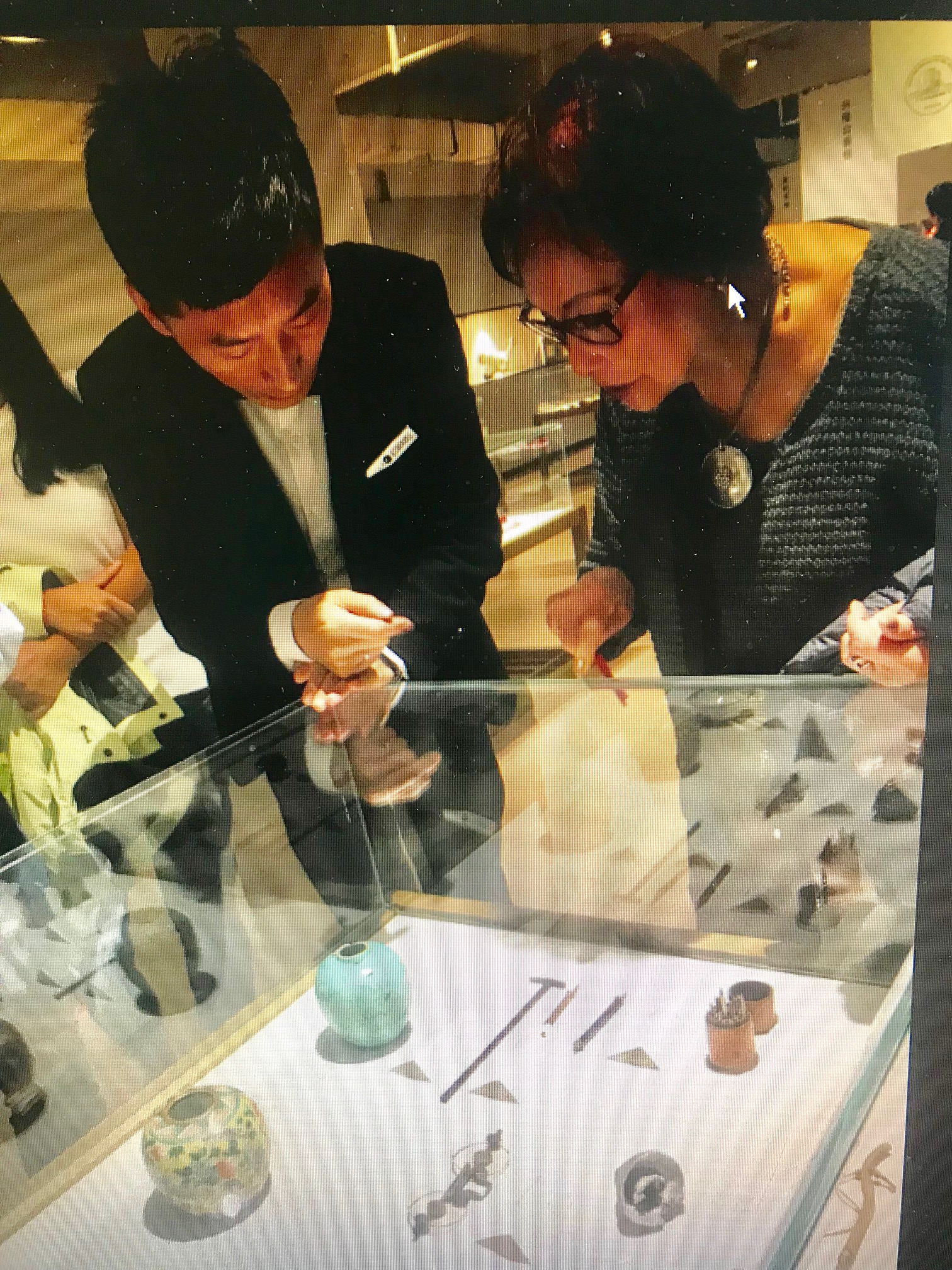
Dinner was at the local Museum where we had the opportunity to see examples of the area’s crafts and history before dining. One interesting dish was a braised duck wrapped in edible straw which when opened, the chef came out to show us a hand pulled meat demonstration. Another interesting entrée featured lamb tail, something new to all of us. Since this is usually a cold area, it is interesting that many of the entrees were served with hot stones embedded within the food items, so we had to be careful not to pick up the stone to mistakenly eat.
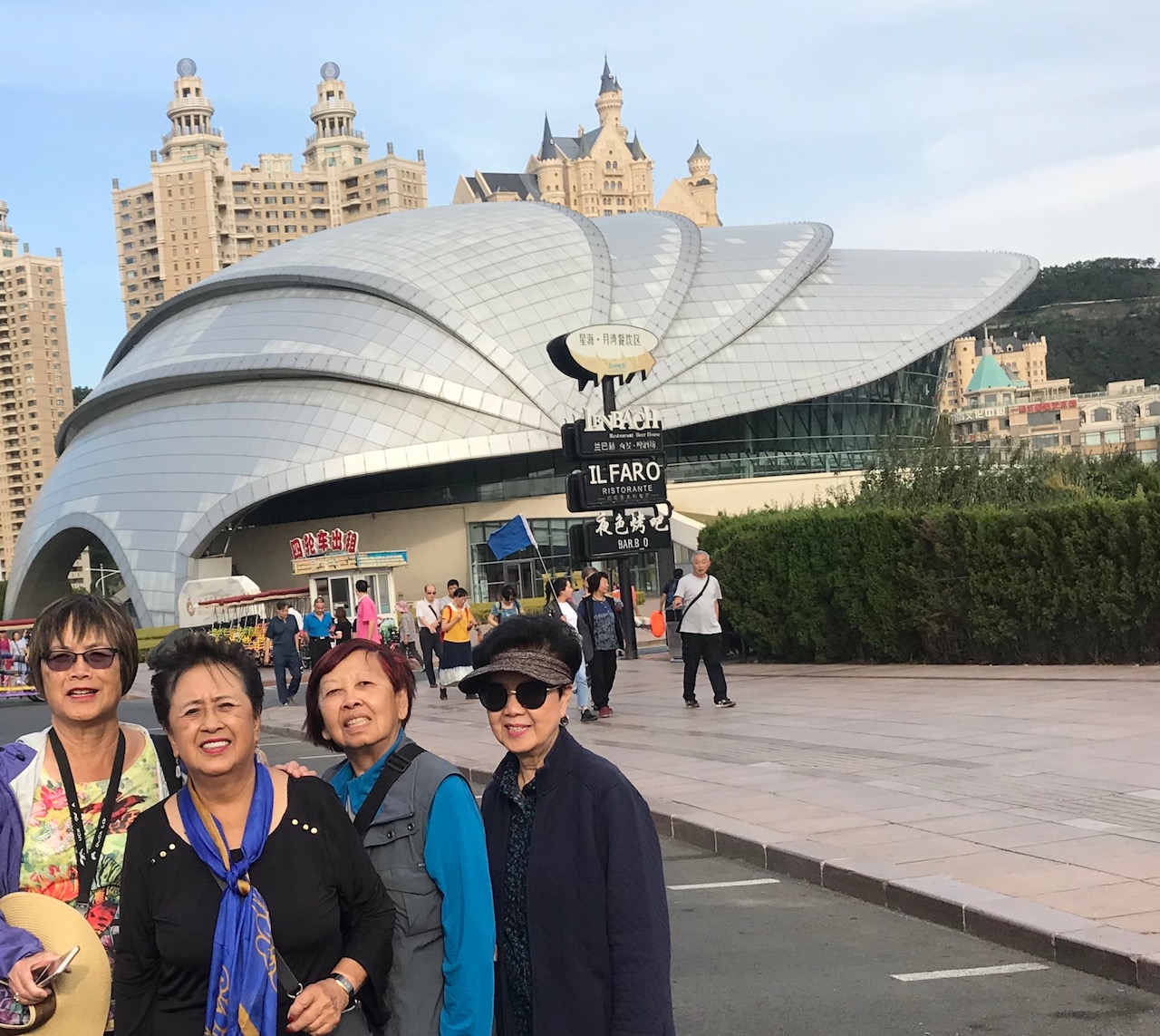
Final Day in China brought us by Bullet Train to large commercial modern Dalian City where we visited its traditional harbor sights, the Xinghai Square and Tiger Status Park.
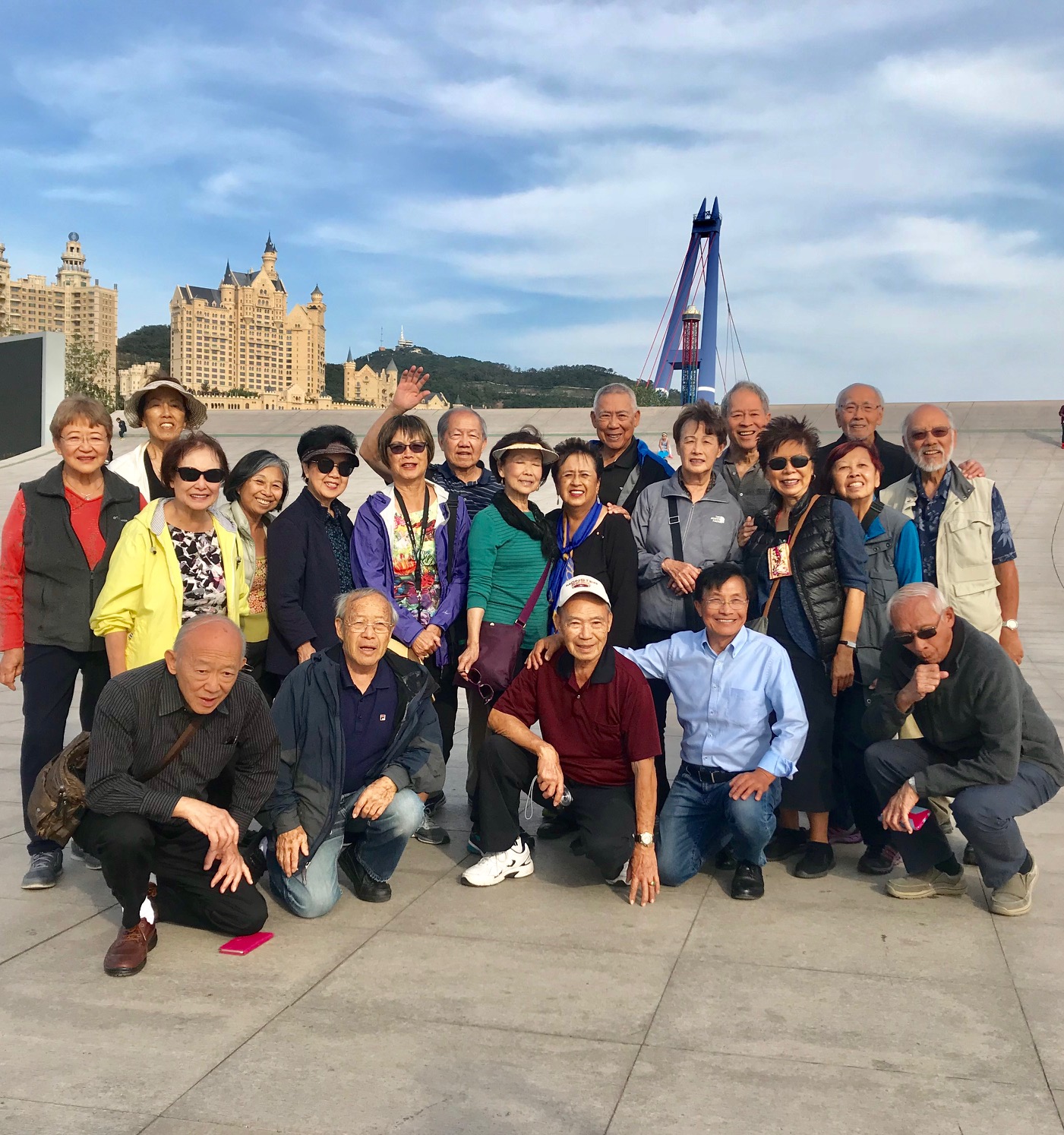
It is a beautiful town with Russian architectural influences, and a popular tourist site for local Chinese to have family vacations due to its good weather and beaches.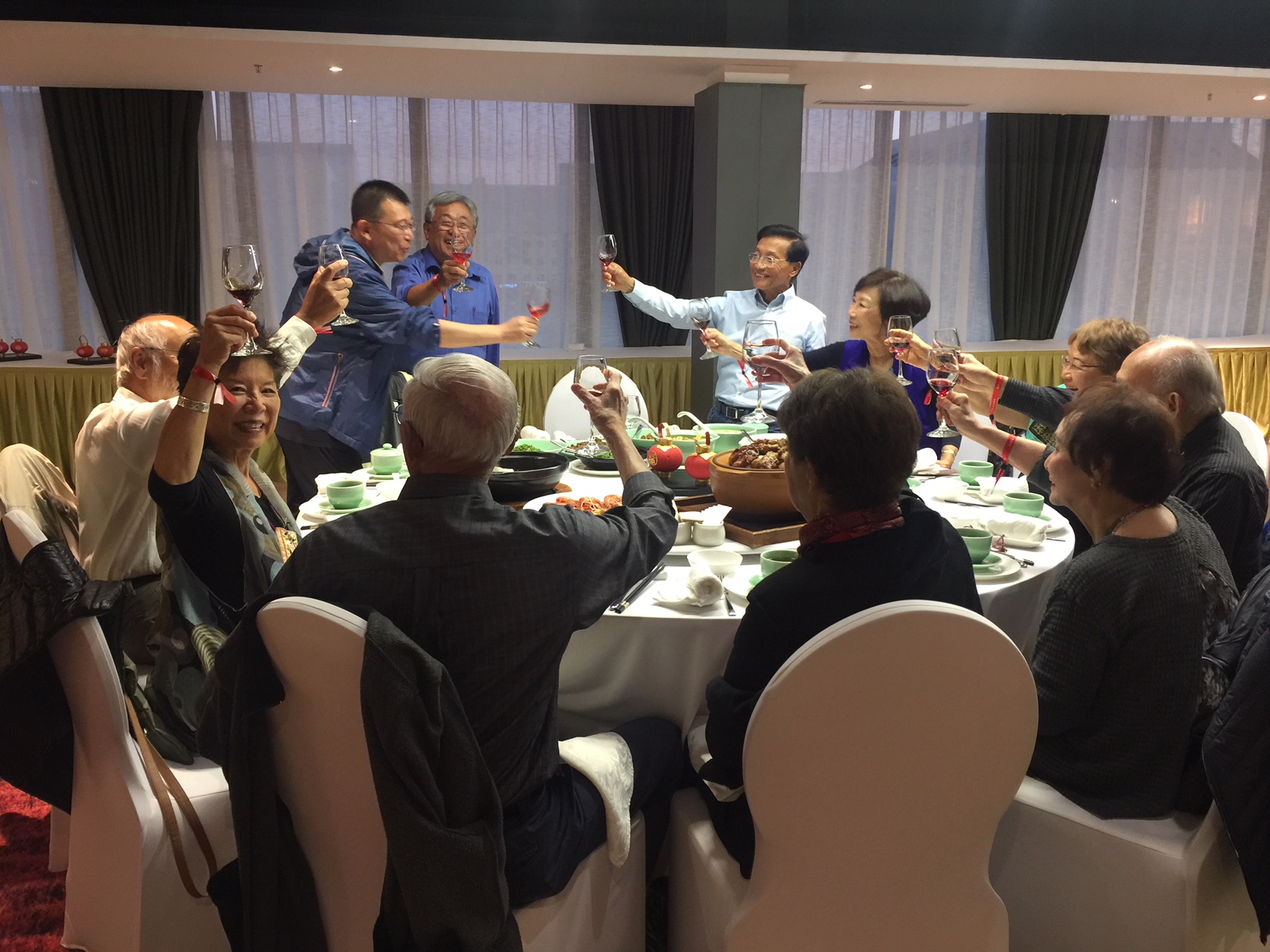
It is a long travel day for all of us to fly back to Beijing and then on to home US shores. Once again we have traveled far and wide but only seen another small piece of China’s natural and man-made wonders. Travel is always made more pleasurable by the people who share the experience with you, so I must thank my fellow wandering Chinese American friends for a great 2018 experience, with always the hope we will meet once again next year to see another slice of this wonderful country of China!
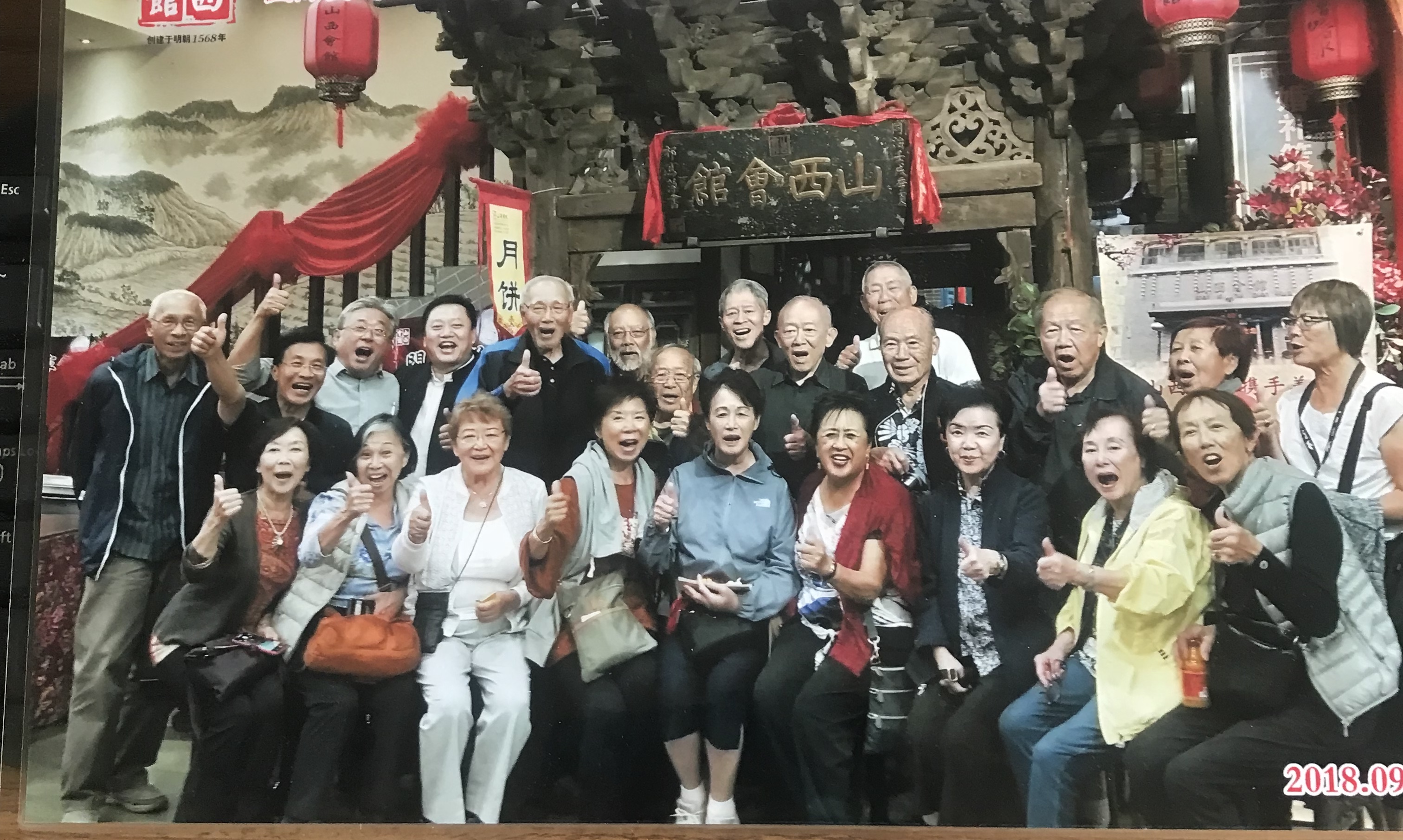
I hope I have enticed some of you with a desire to visit and learn more about how this great country is developing and preserving its history and culture and scenic sights for visitors to enjoy. China welcomes you and its tourist facilities are improving every year. See you there?
